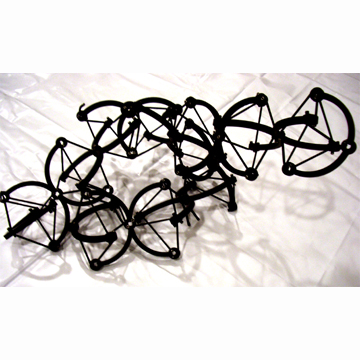
The force sensor designed to measure the tendon tension within the tensegrity structures. It is a small spring attached to a magnet within a steel housing. A hall-effect sensor measures the displacement of the magnet, which is proportional to the tension.
A motor would then actively control the tension in a cable strung between two compression elements of the structure.
 |
|
 |
 |
A detail of the first prototype structure. Our goal was to build a modular construction kit, like Legos, for building arbitrary tensegrity robots. In this protope, elastic bands were clamped in place by nylons balls.
The first Biot prototype, a tetrahedron tensegrity structure. The concept was to build a modular tensegrity robot kit. Motors could be attached to arbitrary compression elements. These would actively control the tension in the structure, causing the structural shape to deform. The structural deformation allows the robot to locomote or execute simple behaviors [feeding/light-avoidance].
The first Biot prototype had a single DOF and could self-flatten and reform its shape by controlling the tension in the tetrahedron.
A second Biot prototype was buit out of lasercut ABS. This allowed rapid construction of tensegrity structures with branching and limb-like forms.
Biot arose out of the Living Machines Project with Prof. Rodney Brooks. The project was interested in leveraging the structural and organizational principles which gave rise to life in order to build more adaptive and robust robots.
Biot is a tensegrity robot. Our research with Biot is concerned with the autonomous development of physically embodied robots. We are looking at simple invertebrates such as the leech and the jellyfish to provide models of neural and morphological development. By taking a computational approach to such models, we hope to confirm experimental biological findings and to elucidate the underlying set of tools that nature employs in the development of an organism. Currently, mechanisms of neurogenesis and morphogenesis, along with neural plasticity, are the primary areas of investigation. In addition, we are looking at homeostatic systems and artificial chemistries as components of the developmental program. These models of living systems can provide a framework within which tools such as evolutionary search can find system architectures and morphologies for the robots.
The robots being built for this purpose are based on the structural phenomena of tensegrity. Tensegrity structures, discovered in part by Buckminster Fuller, contain isolated compression beams seemingly floating in a sea of elastic tension provided by cables. This highly efficient building technique is widespread in biological systems, from the cell membrane to the musculature system. The tensegrity robots under construction are to be highly compliant and driven by force-actuation. As such, they can provide rough models for organisms such as the leech and jellyfish.
This project is no longer active.

